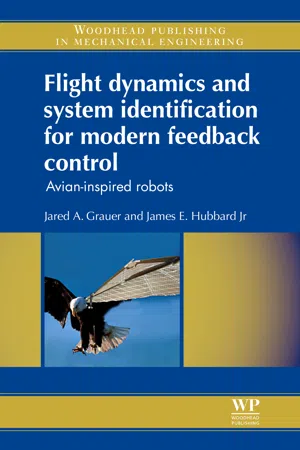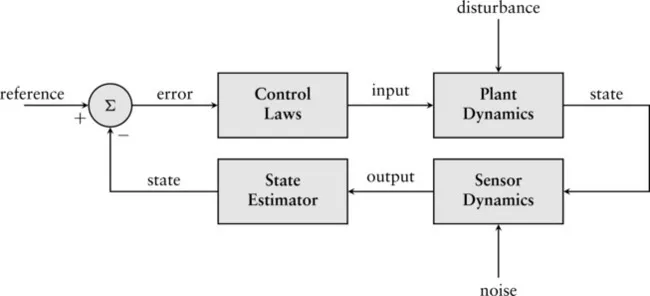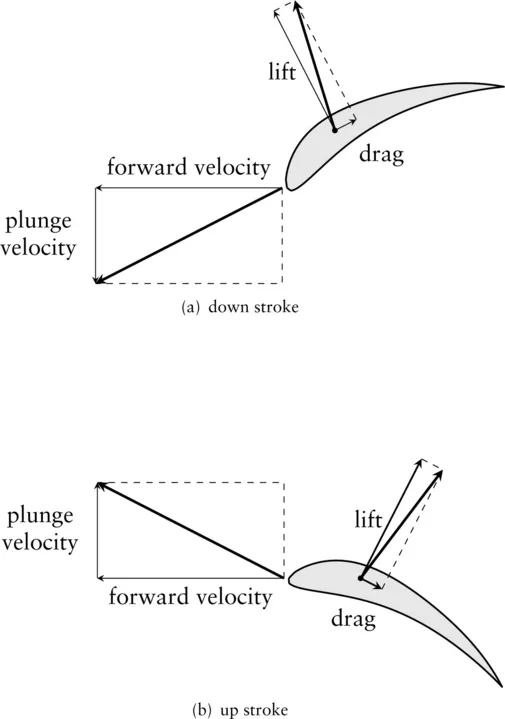
Flight Dynamics and System Identification for Modern Feedback Control
Avian-Inspired Robots
- 160 pages
- English
- ePUB (mobile friendly)
- Available on iOS & Android
Flight Dynamics and System Identification for Modern Feedback Control
Avian-Inspired Robots
About this book
Unmanned air vehicles are becoming increasingly popular alternatives for private applications which include, but are not limited to, fire fighting, search and rescue, atmospheric data collection, and crop surveys, to name a few. Among these vehicles are avian-inspired, flapping-wing designs, which are safe to operate near humans and are required to carry payloads while achieving manoeuverability and agility in low speed flight. Conventional methods and tools fall short of achieving the desired performance metrics and requirements of such craft. Flight dynamics and system identification for modern feedback control provides an in-depth study of the difficulties associated with achieving controlled performance in flapping-wing, avian-inspired flight, and a new model paradigm is derived using analytical and experimental methods, with which a controls designer may then apply familiar tools. This title consists of eight chapters and covers flapping-wing aircraft and flight dynamics, before looking at nonlinear, multibody modelling as well as flight testing and instrumentation. Later chapters examine system identification from flight test data, feedback control and linearization.- Presents experimental flight data for validation and verification of modelled dynamics, thus illustrating the deficiencies and difficulties associated with modelling flapping-wing flight- Derives a new flight dynamics model needed to model avian-inspired vehicles, based on nonlinear multibody dynamics- Extracts aerodynamic models of flapping flight from experimental flight data and system identification techniques
Frequently asked questions
- Essential is ideal for learners and professionals who enjoy exploring a wide range of subjects. Access the Essential Library with 800,000+ trusted titles and best-sellers across business, personal growth, and the humanities. Includes unlimited reading time and Standard Read Aloud voice.
- Complete: Perfect for advanced learners and researchers needing full, unrestricted access. Unlock 1.4M+ books across hundreds of subjects, including academic and specialized titles. The Complete Plan also includes advanced features like Premium Read Aloud and Research Assistant.
Please note we cannot support devices running on iOS 13 and Android 7 or earlier. Learn more about using the app.
Information
Introduction
Abstract:
1.1 Background and motivation

1.2 Bio-inspired flapping wing aircraft

1.3 Flapping-wing literature review
1.3.1 Vehicle design
Table of contents
- Cover image
- Title page
- Table of Contents
- Copyright
- Dedication
- List of figures
- List of tables
- Nomenclature
- Preface
- About the authors
- Chapter 1: Introduction
- Chapter 2: Ornithopter test platform characterizations
- Chapter 3: Rigid multibody vehicle dynamics
- Chapter 4: System identification of aerodynamic models
- Chapter 5: Simulation results
- Chapter 6: Concluding remarks
- Appendix A: Field calibration of inertial measurement units
- Appendix B: Actuator dynamics system identification
- Appendix C: Equations of motion for single-body flight vehicles
- Appendix D: Linearization of a conventional aircraft model
- References
- Index